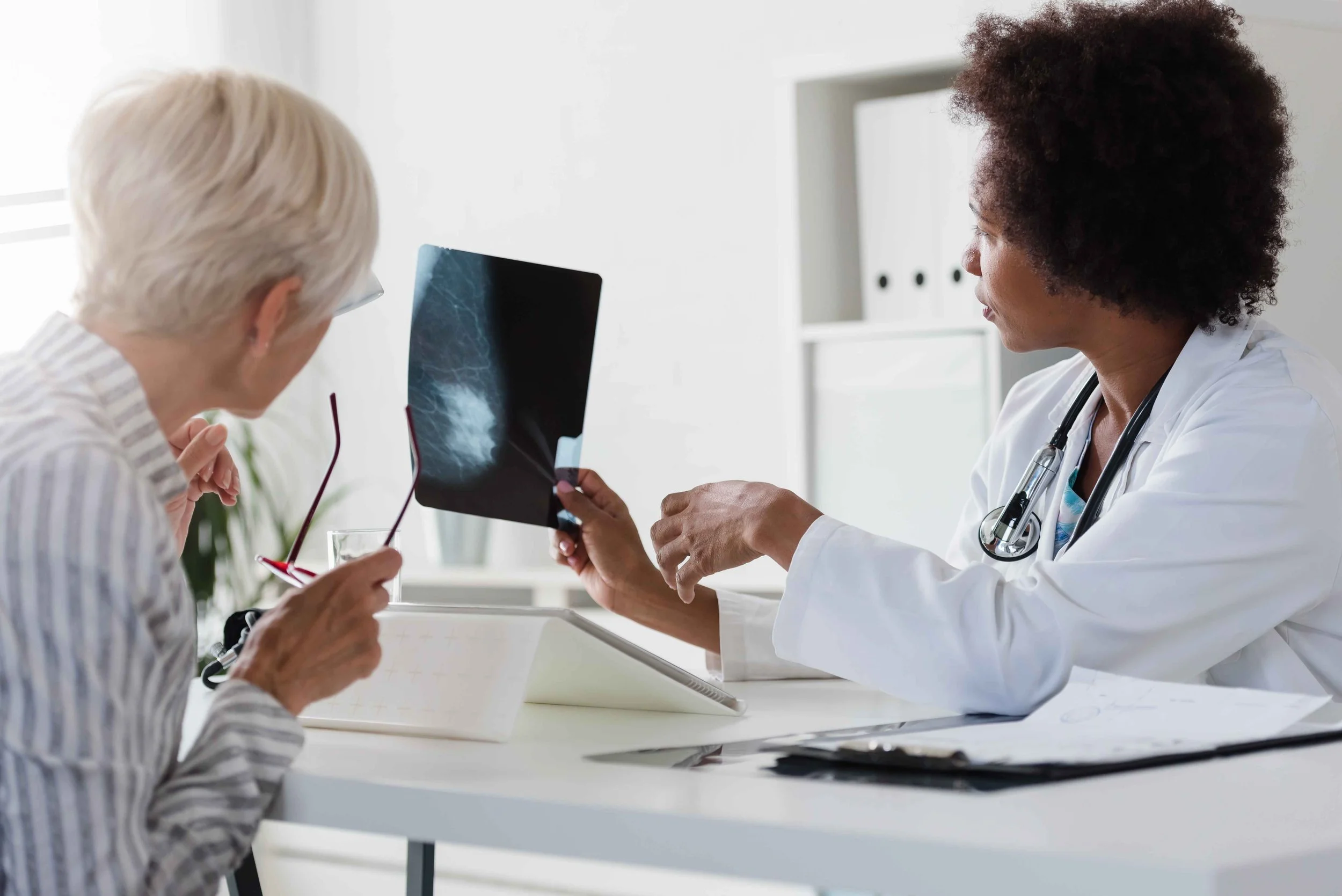Breast Cancer Guide: Everything You Need to Know, From Early Signs to Treatment
This article was reviewed by Mighty Health physician, Eric Tam, MD. Dr. Eric Tam is a board certified family physician. Having received his training at UCSF’s Family and Community medicine program, he recognizes the importance of understanding the world his patients come from. As a result, he approaches every patient with humility and deep empathy.
Mighty Health Answers Common Questions about Breast Cancer
If you or a loved one has recently been diagnosed with breast cancer, are going through or just finishing treatment, or are worried about developing this type of cancer, you probably have a lot of questions. This guide can help you find answers.
What is Breast Cancer?
Like other types of cancer, breast cancer is a condition in which abnormal cells reproduce quickly. Abnormal breast cells, which don’t function normally, can prevent healthy breast cells from doing their job. In large numbers, cancer cells can prevent the breast itself from functioning properly.
Each breast contains 15 to 20 lobes, arranged in a circular fashion. Each lobe contains many lobules, which are tiny bulb-like glands that produce breast milk. Ducts connect the lobes, lobules, and glands to deliver milk to openings in the nipple.
The breast tissue lies on top of a layer of muscle, which separates the breast tissue from the ribs.
Where Does Breast Cancer Start?
Breast cancer can start in different parts of the breast. Most breast cancers start in the ducts, but some types develop in the lobules. A few types of cancer start in other tissues of the breast, but these are less common.
What Is Metastasis?
Breast cancer can spread, or metastasize, to other parts of the body. The abnormal breast cancer cells can spread to nearby breast tissue and to the lymph nodes, which are small bean-shaped organs that help fight infection.
The breast cancer cells may eventually metastasize to areas of the body far away from the breasts. Breast cancer most commonly spreads to the bones, lungs, brain, and liver.
How Does Cancer Spread?
Cancer spreads through one or more ways. The cancer cells can invade nearby healthy cells, for example, and these cells can then produce more abnormal cells. Cancer cells can also penetrate the walls of blood vessels or lymph vessels to enter the circulatory or lymphatic systems. Once in the bloodstream or lymphatic vessels, the cancer cells can travel to other parts of the body.
The cancer cells stop moving when they reach distant locations and become lodged in capillaries, which are tiny blood vessels that deliver oxygen and nutrient-rich blood to the cells of the body. Once there, the cancer cells can form new tumors.
How Common Is Breast Cancer?
After skin cancer, breast cancer is one of the most commonly diagnosed type of cancer in the United States among women, according to the Centers for Disease Control and Prevention (CDC). In 2020, doctors diagnosed 239,612 new breast cancers in females; 42,273 females died from the disease that year. About 1 in 8 women will develop invasive breast cancer in the course of their life.
Can Men Get Breast Cancer?
Yes! While breast cancer develops mainly in women, men can also develop breast cancer.
Both men and women have breast tissue, consisting of a few ducts located under the nipple and area around the nipple, known as the areola. When girls go through puberty, their ovaries make female hormones that cause the breast ducts to grow and lobules to form at the end of these ducts. Boys and men have very low levels of these female hormones, so their breast tissue doesn’t grow as much. Men generally have ducts but only a few, if any, lobules.
Doctors in the United States will diagnose about 2,800 new cases of breast cancer in men in 2023, according to estimates by the American Cancer Society. Breast cancer will claim the lives of about 530 American males during that year.
What Are the Different Types of Breast Cancer?
Doctors group breast cancers into several types, depending on the specific cells in the breast that become cancer, how much the cancer has spread, and certain features that shape how the cancer cells behave.
Breast cancers tumors can be benign or malignant. A benign tumor is non-cancerous, which means it is not aggressive towards healthy tissue. Malignant tumors can invade and damage surrounding healthy tissue.
Non-Invasive Breast Cancer
Healthcare professionals say that breast cancer is invasive, or infiltrating, when it spreads into surrounding breast tissue. Non-invasive, or in situ, breast cancer has not spread beyond where it started.
Two forms of non-invasive breast cancers exist:
Ductal carcinoma in situ (DCIS) – has not spread beyond the milk ducts where it started
Lobular carcinoma in situ (LCIS) – has not spread beyond the lobules where it started; LCIS is benign, and is therefore not a “real” breast cancer
Invasive Breast Cancer
Inflammatory Breast Cancer
In this type of aggressive breast cancer, the cancer cells block the lymph vessels in the patient’s skin, which causes the breast to look inflamed. Inflammatory breast cancer is rare, accounting for only about 1 to 5 percent of all breast cancer cases.
Triple Negative Breast Cancer
When diagnosing breast cancer, doctors perform a number of tests. Doctors may test for the presence of a protein called HER2, for example, which some cancer cells may produce. They may also test for the presence of special proteins, known as receptors, on the surface of breast cancer cells. These receptors can attach to certain substances, such as the hormones estrogen and progesterone.
In triple negative breast cancer, the cancer cells do not have estrogen receptors (ER) or progesterone receptors (PR), and they don’t make much (if any) HER2 protein.
Triple negative breast cancer is a very aggressive form of invasive cancer, and is difficult to treat. It accounts for about 15 percent of all breast cancers.
Metastatic Breast Cancer
Also known as stage IV breast cancer, metastatic breast cancer is a condition in which breast cancer cells have spread to other parts of the body, such as the brain, bones, lungs, or liver.
What Are the Stages of Breast Cancer?
Doctors describe cancer in terms of stages. There are five stages, 0 through 4 (written as 0, I, II, III, and IV). The higher the number, the more the breast cancer cells have spread. The doctor stages the cancer when the patient is first diagnosed. If someone has stage II breast cancer and it spreads to their bones, they have stage II breast cancer with metastasis to the bones.
When staging cancer, doctors also use the TNM system to add more information to the description:
T – Tumor size in centimeters (cm)
N – Number of nearby lymph nodes containing cancer cells
M – Metastasis to other parts of the body, with 0 as no and a 1 as yes
Doctors may describe the tumor as “tumor in situ,” or Tis, which means that cancer cells are found only in the specific area where the cancer started. If no lymph nodes are affected, the doctors may stage it as N0 and M0.
Stages of Breast Cancer
Stage 0
At stage 0, the abnormal breast cells are found only in the ducts and lobules of the breast; the cancer cells haven’t spread to nearby tissue. Doctors may refer to this as noninvasive cancer (Tis, N0, M0).
Stage I
At stage I, cancer cells are present in normal breast tissue. Doctors often describe stage I breast cancer as “invasive” or as T1, N0, M0.
Stage II
Stage II is invasive breast cancer. The abnormal breast cells remain in a small area, but the tumor has grown larger.
Stage III
In stage III breast cancer, the abnormal cells have spread further into breast tissue or the tumor is larger than in the earlier stages.
Stage IV
Stage IV is the most advanced stage of breast cancer in that it has spread to nearby lymph nodes and to tissue in distant parts of the body beyond the breast.
Is there a Way to Detect Breast Cancer?
Screening saves lives in that it can detect cancer early, before signs and symptoms appear, and when it is easiest to treat. Mammograms can help detect breast cancer in people who appear to be healthy, and are not suspected to have breast cancer. Mammograms are an x-ray picture of breast tissue; doctors have used mammograms to screen for breast cancer for more than 50 years. The USPSTF recommends biennial screening mammography for women ages 40 to 74 years.
Genetic tests can help patients determine their risk for developing hereditary breast cancer. These tests look for mutations in the BRCA1 and BRCA2 genes, which are the genes most commonly affected in hereditary breast cancer. Being positive for these genes means a woman is at higher risk for breast cancer.
What Other Tests Do Doctors Perform?
Ultrasounds are not routinely used to detect breast cancer, but they are helpful for looking at changes within the breast. Biopsies are procedures in which doctors retrieve a sample of cells from within the suspicious mass and test the tissue in a laboratory.
What Does Breast Cancer Look Like?
The most well-known symptom of breast cancer is a lump, but it is possible to have breast cancer without a lump, so it is important to know the other signs and symptoms of breast cancer. Symptoms vary according to the type of breast cancer.
Early signs and symptoms of breast cancer include:
A breast lump located anywhere along the chest wall to the armpit; the lump may or may not be painful
Nipple bleeding or discharge, along with related pain
Redness and/or swelling in any area of the breast, or in one breast but not the other
Nipple that appears flat or caved in
How Do I Perform a Breast Self Examination?
Performing a breast self-check can help you detect lumps and other problems in between your mammograms. It can also help you become familiar with how your breasts look and feel.
It’s useful to do a breast self-examination about once a month. If you are still having your periods, perform a self-check a few days after your period stops.
For best results, perform a breast self-exam in three parts: in the shower, in front of a mirror, and lying down.
Shower
In the shower, use the flat parts of your 3 middle fingers to check your entire breast and armpit area; press down gently with light, medium, and firm pressure. Examine both breasts each month, and check each breast for any new lumps, hardened knots, tissue thickening, or other changes.
Mirror
Next, stand in front of a mirror with your arms down by your sides. Visually inspect your breasts for changes in their shape, dimpling, swelling, or changes in your nipples. Now rest your palms on your hips and press your hands firmly against your body to flex your chest muscles. Look for dimpling, puckering, or other changes, particularly on one side.
Lying Down
Lying down allows breast tissue to spread out evenly along your chest wall. Place a pillow under your right shoulder and put your right arm under your head. Using the pads of your left fingers, check your entire breast and armpit area for lumps, knots, thickening, or other changes. Examine your left breast in the same way.
What Is the Treatment for Breast Cancer?
A number of treatments are available for breast cancer. A cancer doctor, known as an oncologist, can recommend a course of treatment depending on the type of breast cancer the patient has and how far it has spread. People with breast cancer often undergo more than one type of treatment.
Surgery
Surgeons perform several types of surgery for breast cancer:
Mastectomy – the surgeon removes the breast tissue, including some skin and the nipple, and the tissue that covers the chest muscles; the surgeon leaves the chest muscles intact
Lumpectomy – a breast-sparing procedure in which the surgeon removes only the cancerous lump
Breast-sparing surgery, such as a partial mastectomy – the surgeon removes the cancerous mass along with some normal tissue surrounding the cancer; the doctor may remove one or more lymph nodes from under the patient’s arm
Radical mastectomy – the surgeon removes the breast tissue, nipple, the areola around the nipple, the lymph nodes under the arm on the affected side, and the chest muscles under the breast
Mastectomy with reconstruction – after mastectomy, the surgeon uses an implant or tissue from another part of the body to create a breast-like shape
Chemotherapy
Chemotherapy uses anti-cancer chemicals, known as cytotoxic drugs, to kill cancer cells or prevent their spread.
Radiation
Radiation treatment uses high-energy rays to kill cancer cells. Oncologists may recommend radiation after breast-conserving surgery to help lower the risk that the cancer will come back, or after a mastectomy in some cases. Radiation may also be helpful if the cancer has spread.
Other treatments
Other treatments include hormone therapy, targeted drug therapy, and immunotherapy.
How Can I Support Someone with Breast Cancer?
While each person with breast cancer has a different journey and unique needs, almost everyone with the disease can benefit from emotional and practical help. Of course, not every person with breast cancer wants the same type of support, so try to let your friend or family member with breast cancer take the lead. Listen carefully for cues, but don’t be afraid to ask what they need.
Offering your friend or family member emotional support is more powerful than you might think, as cancer (and watching someone you love go through cancer) can be a lonely journey. Simply checking in with your friend or family member can be helpful – for both of you. Emotional support may include being available to listen, even in the middle of the night.
Practical support is also helpful. You can prepare home-cooked, freezer-ready meals and snacks, for example, or offer help with housework, pet care or laundry. Offer a lift to doctor appointments, treatments or shopping. Be sure to ask for other suggestions, as each person with breast cancer has their own unique challenges.
Mighty Health Support
Mighty Health is your home for healthy living! For more information on over 50 health, consult with a Might Health coach! Get personalized exercise, nutrition, and health guidance to meet all of your goals and live the best years of you life.






